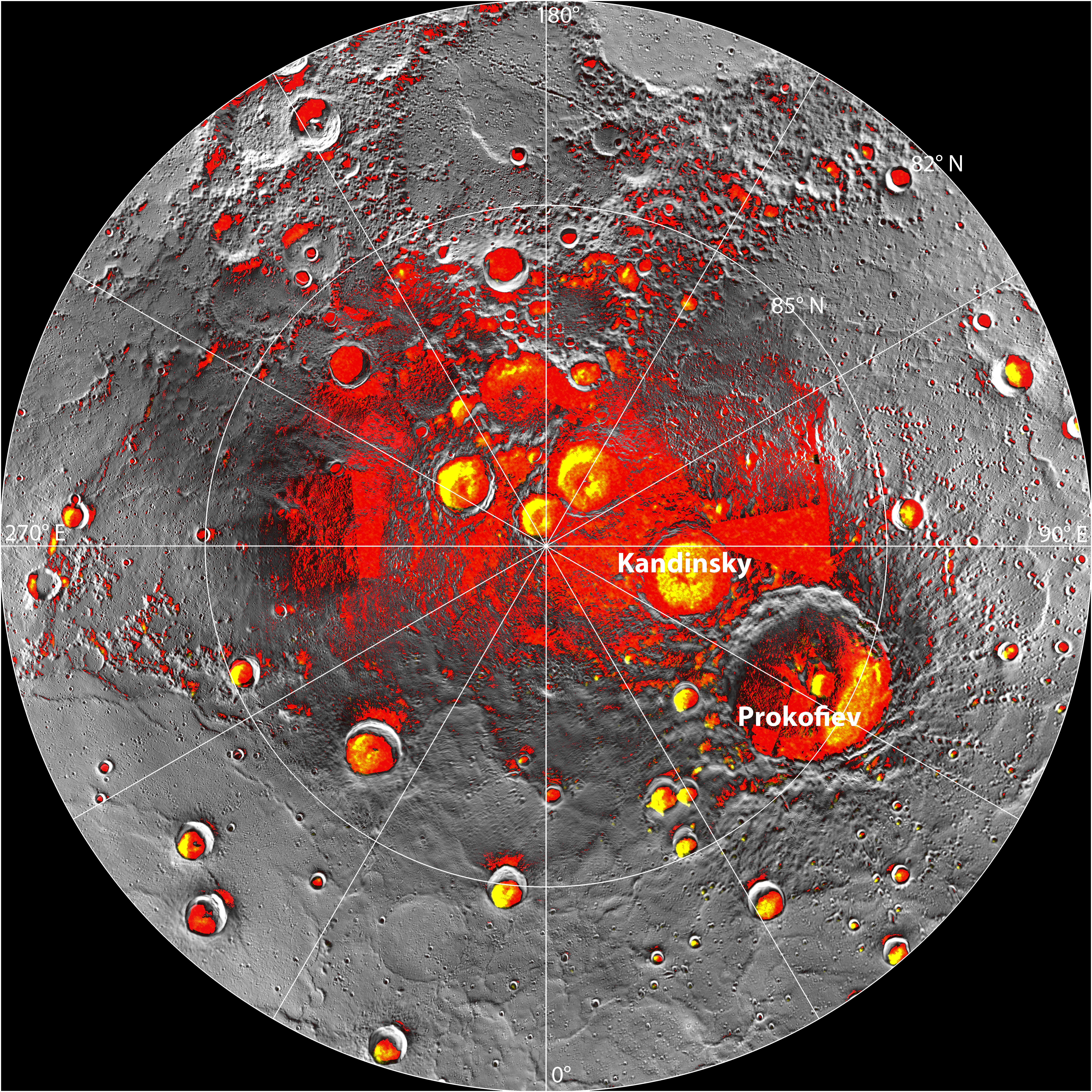The MESSENGER mission to Mercury is winding down. The navigation thrusters are exhausted, and the team have directed their probe to make series of ultra low altitude passes over the surface, so that they can make the most use of the magnetometer and the neutron spectrometer (which measure the magnetic field and the surface composition respectively). They're already getting pretty low over the surface, but now they'll come within a few kilometres of Mercury's rocks and take videos like this:
Above: This video was taken by the MESSENGER spacecraft as it flew low over Mercury - keep your eyes open, there are some of the surface features mentioned in tHis post wizzing past the camera! Courtesy of NASA
Something hidden in the eternal night:
 |
| Above: Permanently shadowed craters at the poles of Mercury. Yes, I know they're all red and yellow, that's just the graphics. Courtesy of NASA |
Self repairing black masses, hiding in the bottom of permanently shadowed craters, on a sun drenched planet - now that's the kind of alien phenomena we go into space to discover.
Other sensors carried by MESSENGER, like the radar sounding experiment, suggest that there’s a layer of water ice beneath the black material, so the leading theory is that the ice in the craters has some kind of organic material mixed in with it. As ice in these these craters isn't stable over the long term the ice gradually evaporates, leaving behind a layer of organic chemicals on the surface. The layer then protects and preserves the remaining ice. If the layer is breached then the newly exposed ice repeats the processes. These organic materials could even contain compounds related to the origin of life, as similar deposits on the moon are thought to.
But right now this is just our best guess - this might be possible if the ice was mainly due to accumulated comets strikes, as they’re rich in both ice and organics. But if the water molecules are formed chemically from solar wind and the rocks it’s harder to see where the organics could be coming from.
Different flavours of hollows:
Crater counting shows them to be geologically young, and probably forming still today. But exactly what process has created them… it’s a mystery.
One idea is that there are stores of volatiles below the surface, and that, as these evaporate beneath the blazing Sun, they cause the ground to collapse. But again, we're into 'best scientific guess' land here. To thicken the plot: At LPSC some of the UV spectrometer results from MESSENGER were revealed, showing that some of the hollows have different surface compositions – this might represent inherent differences, or it might be that some of the craters are older and space weathering has changed their surfaces.
Mercury has turned out to be far from a dead chunk of rock - the above are just a couple of the mysteries we've found there. Wouldn't it be great if there was a follow up mission being developed? well there is, it's called Bepicolumbo!
Above: A quick rundown on the upcoming Bepicolumbo mission, courtesy of ESA.
Elsewhere in the universe:
 |
| Above: A depiction of the Methyl Cyanide molecule. The 'H's are hydrogen atoms, the 'C''s are carbons, and the N is a nitrogen |
Molecules implicated in the origins of life have been spotted in a still forming solar system. The Methyl cyanide molecule, and its simpler sibling hydrogen cyanide, are thought to be amongst the ground level molecules for the chemical evolution that leads to life, so their detection suggests that they’re present in a lot of young planetary systems – great news for alien hunters as it raises the possibilities of finding worlds with the chemistry needed for life. This isn’t the first time complex , life related molecules have been found – sugars have been found, amino acids have been shown to form on interstellar dust, and tar like compounds have been found in distant reaches of the universe. But this is the first time molecules so directly life related have been found in a growing solar system – not too dissimilar to the way our own is thought to have been 4.5 billion years ago.
SpaceX is going to make another attempt to land and re-use it's Falcon 9R rocket. their last attempt came close but...well here's the video:
Lastly, this is pure science fiction, but it's awseome. And it's being made into a movie!
Above: Owch. But, I should point out, SpaceX shared this video themselves - that's how sure they are they know what went wrong and can get it right.
Lastly, this is pure science fiction, but it's awseome. And it's being made into a movie!
Elsewhere on the internet:

No comments:
Post a Comment